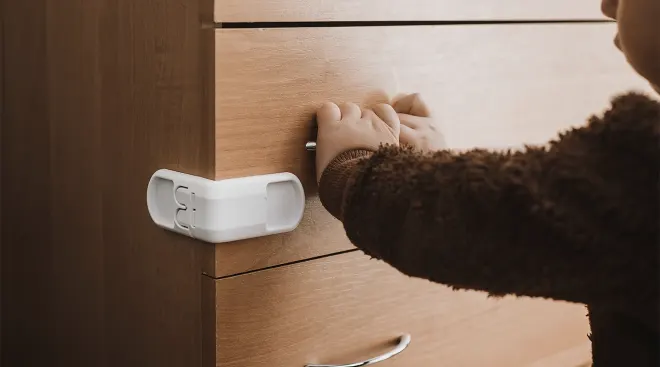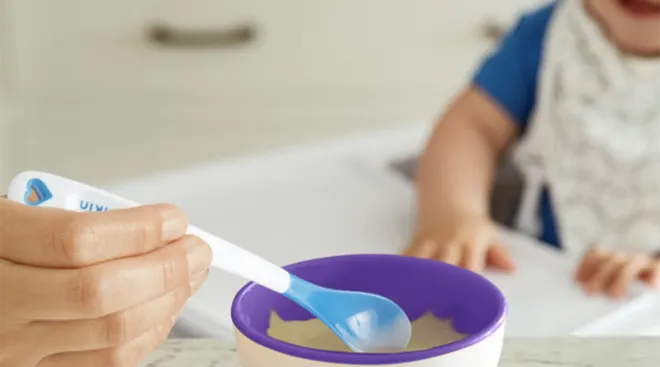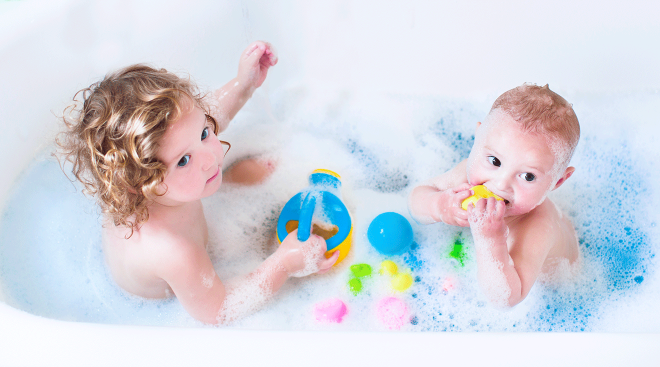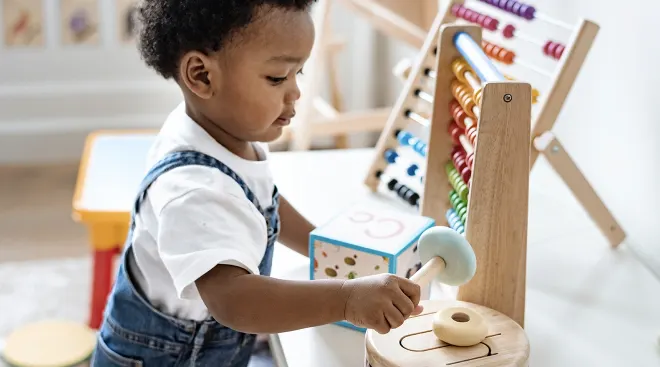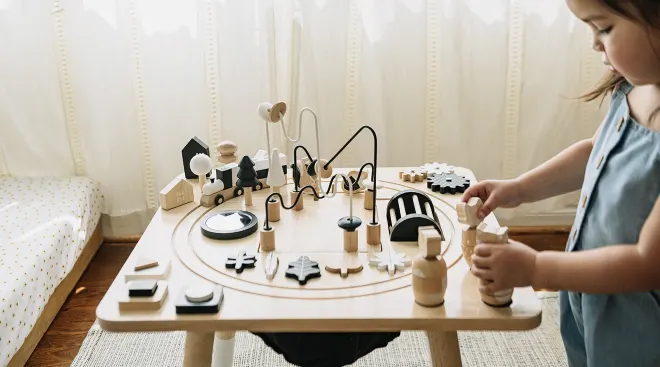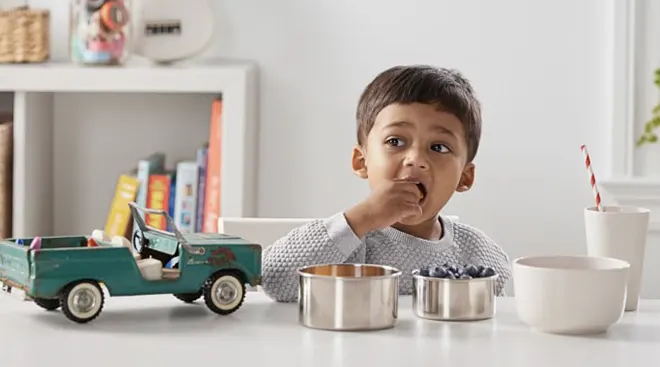10-Month-Old Baby

Baby’s 10 months old! Life might be pretty chaotic right now, since you have a soon-to-be toddler on the move. (But don’t all those hugs and kisses make it worthwhile?) It’s so fun to watch your 10-month-old baby grow and develop every day—although it’s still totally normal to question every decision and wonder if they’re meeting all the 10-month baby milestones.
You’re likely getting excited as baby’s first birthday draws near—and starting to get a lot more confident about this whole parenting thing. But as baby gets more mobile, more comfortable with different foods and maybe even sleeps better, you’re still sure to have plenty of questions about their development. Ready to get the scoop on everything you’ll want to know about your 10-month-old baby? Read on for all the important info.
- Baby might be pulling up to stand while holding onto furniture—aka cruising. (Pretty soon, they may even let go!) Make sure everything they grab is safe and secure.
- On that note, you may have already babyproofed the house, but it’s important to supervise baby when they’re scooting, crawling or starting to stand to keep them out of harm’s way.
- Baby might be saying “mama” or “dada”—if they aren’t yet, keep your ears peeled for those first words soon!
How much should a 10-month-old weigh? The average weight of a 10-month-old baby is 18.7 pounds for girls and 20.2 pounds for boys. Average length is 28.1 inches for girls and 28.9 inches for boys. Baby may be growing about half an inch each month and gaining about .5 to 1 pound per month.
If baby doesn’t seem to be putting on pounds, you can talk to your pediatrician. They might advise you to try to give them more high-calorie foods, like yogurt, eggs, avocado and nut butters. But, in general, if baby’s following their growth curve, it’s all good.
What should a 10-month-old be doing? Milestones at this age can vary from baby to baby, but here’s what your little one might be up to:
- Crawling. Baby may have started crawling by now—but a 10-month-old not crawling is not typically a cause for concern. In fact, some babies never crawl at all—they go straight to walking! Encourage baby to crawl by positioning their favorite toy just out of reach—and cheer baby on!
- Standing. Baby may be able to stand upright while holding onto a piece of furniture, aka cruising. (And in a matter of months, they may be letting go!)
- Hand skills. A 10-month-old baby can often pick things up using their thumb and pointer finger (aka the pincer grasp) and has learned how to point (at anything and everything exciting) too. A 10-month-old baby may start using their fingers to self-feed. This is a great time to practice waving “bye-bye” and blowing kisses. Baby will love it!
- Talking. What should a 10-month-old be saying? About half of 10-month-olds say “mama” or “dada” to refer to their parents. (Aw!) Within the next two months or so, baby will likely know how to say one to three words.
10-month-old sensory development
- Baby isn’t just able to hear everyday sounds, but they recognize them too—your voice, their older sister’s voice, the doorbell and more.
- Baby may pay attention to the noises they know are important and ignore the ones that aren’t.
- Baby also knows what to do with their hands. When they have a rattle, they shake it; when they see a button on a toy, they push it.
“Nothing works better to encourage speech and communication at any age than constantly speaking and communicating with your little one. Say everything you’re doing out loud, sing, read aloud, use gestures and even consider introducing baby sign language. Also, remember that the background noise of televisions and the like aren’t the same as hearing you talk and, if anything, they drown out the really important stuff.” — Chris Klunk, MD, board-certified neonatologist at Pediatrix Medical Group in Austin, Texas
Every month, you’ll likely have different questions about baby’s health. Here are some topics you might want to know about at the 10-month-old stage.
When to switch out your infant car seat
Baby may seem a lot bigger, but they should stay in a rear-facing car seat for as long as possible, ideally until they’re 3 years old or when they physically outgrow the rear-facing car seat, advises the National Highway Traffic Safety Administration (NHTSA). At 10 months old, your little one will likely still fit in their infant car seat. Once they reach the weight and height limit for that infant car seat, you should move them into a convertible or all-in-one car seat where they’re still able to sit rear-facing. Always make sure your car seat is properly installed and not moving or wiggling around too much. Don’t put bulky clothes like jackets or large sweatshirts on baby when they’re in their car seat, since this can lead to increased risk of injury.
Tylenol and Advil for babies
At 10 months old, most babies can safely take Tylenol (acetaminophen) and/or Advil (ibuprofen) (of course, every situation is different, so you should always check with your pediatrician). These medications are helpful for treating pain—such as from teething—and reducing fevers. The dose typically depends on baby’s weight.
In some cases, getting baby to actually take the medication can be tricky. Using a syringe can help: Just make sure they swallow the medication and don’t just spit it out. You can also try giving them a spoonful of food they like right before giving the medicine, but avoid mixing it into large volumes of food or a bottle because they may not take the entire amount.
Effects of smoking or vaping around baby
Smoking or vaping around baby can be dangerous—at any age. Breathing in nicotine and other harmful chemicals leads to a greater risk of asthma, respiratory illness and behavioral and developmental problems in babies and children. The best thing you can do is quit—or, at the very least, make your house and car smoke- and vape-free areas. Make sure baby’s caregivers are smoke- and vape-free too.
Why is baby throwing up?
There are many possible reasons for baby throwing up at this age, including a stomach virus, a reaction to something they ate, reflux or simply eating too quickly. Usually, if there aren’t any other symptoms, a one-off vomit isn’t much to be concerned about, but if the throwing up is frequent, forceful and/or painful, it’s worth calling your pediatrician. Additionally, if the vomit includes a green or red color (that’s unrelated to anything baby recently ate), this could be a sign of bile or blood and should prompt a call to the doctor. Keep in mind that persistent throwing up can lead to dehydration, so keep an eye out for signs like fatigue, decreased urination, dry mouth or a lack of tears, and call your doctor if you’re worried.
Checkup and vaccines
At 10 months, you and baby get a break from well-baby visits and vaccines. You’ll come back to the pediatrician when baby’s 12 months old—best to make your appointment now! In the meantime, keep monitoring baby’s development. If there were 9-month milestones they didn’t quite meet, they’re likely to meet them soon. If they’ve mastered all of their nine-month marks, then watch as they start to work toward some 12-month-old milestones like waving, pulling up to stand and saying words like “mama” and “dada.”
This month, you can continue to breastfeed and/or give baby bottles, but know that you might notice a dip in the amount of formula or breast milk they take in, since they’ll be eating more and more solid foods. Baby’s also getting a lot more independent when it comes to self-feeding: Your 10-month-old baby may drink from a bottle, sippy cup or a straw cup all by themselves or grab the cut-up bananas on their high-chair tray. (Make sure you never leave baby eating alone though!)
Read on for the nitty-gritty of feeding your 10-month-old baby.
How much should a 10-month-old eat and drink?
Baby might have a hearty appetite, and they’re probably willing to try lots of different things (picky eating is more of a toddler problem). Enjoy the culinary curiosity while it lasts!
- Breastfeeding: Feedings are typically about every four to five times per day but each breastfed baby may be slightly different. What’s important is that baby seems content, your breasts seem to have been emptied (they’re soft) and baby’s gaining weight healthily. In a 10-month-old, biting might become a breastfeeding hiccup. If baby tries to bite you during a feeding, strictly tell baby “no” and end the feeding, putting them down. After a few failed tries, they’ll learn that biting doesn’t fly with you.
- Bottle-feeding: Wondering how much formula a 10-month-old should drink? A 6- to 8-ounce bottle about four or five times per day is usually about right. A 10-month-old refusing the bottle is a common complaint; it could be due to teething pain. Or maybe baby’s just exercising independence! Rest assured that baby will eat if they’re healthy and hungry, but look out for signs of illness, such as fever and fussiness. And if baby won’t eat or drink at all, it’s time to see the pediatrician.
- Pumping: A breastfed baby needs about 25 ounces of breast milk per day—give or take. So you’ll need to divide that by how many feedings your baby typically has. For example, if you feed baby about five times per day, they should get about 5 ounces of breast milk at each feeding.
What can a 10-month-old eat?
You can continue introducing healthy baby food recipes to baby. You might even start feeding them a little bit of what you’re having. Fruits and veggies are fair game—continue to puree them, but now they can have some texture, or if they’re soft, cut them into tiny pieces baby can pick up and nibble on. Try avocado, banana, blueberries, peaches and cooked potatoes, sweet potatoes, carrots and green beans. Other good finger foods for a 10-month-old baby are pasta pieces, O-shaped cereal, scrambled eggs and tofu. Baby might be eating meat too. Shreds of chicken and ground bits of turkey can be picked up and eaten. Ground beef can be cooked into small pieces and served with a spoon.
Meals can gradually become more varied as baby tries and likes new foods. Remember to offer baby a variety of food groups, paying attention to giving them a balance of protein, carbs and healthy fats at each meal.
Some parents complain that their 10-month-old baby is suddenly not sleeping or their 10-month-old wakes up screaming when they previously never did. In a 10-month-old, sleep regression can happen. Because baby’s learning new skills, such as crawling, pulling up to stand and cruising, they might decide they want to practice them… in the middle of the night. It’s hard to get back to sleep after all that activity. Other babies simply miss their parents in the middle of the night and just want to be close to you.
The good news is that babies tend to grow out of regressions like this within a few weeks. Until then, use some of these tricks to try to help baby (and you!) get more restful sleep. If your 10-month-old won’t sleep through the night, it’s not necessarily a problem. But some parents are eager to get themselves a good night’s sleep! If you’re interested in helping your 10-month-old sleep longer stretches, consider sleep training—we have tips on how to do it.
10-month-old sleep schedule
Ten-month-old babies typically need about two naps—one in the morning and one in the afternoon. Your baby may be sleeping as much as 11 or even 12 hours at night, perhaps with no waking up. (That’s cause for celebration!)
Your 10-month-old’s day looks a lot different than it did just a few months ago. There’s a lot more moving and grooving! The day is full of multiple meals, feeding sessions, naps and plenty of playtime. Suffice it to say, you’re both pretty busy! Here’s a sample 10-month-old daily schedule:
Looking for things to do with a 10-month-old? Ten-month-old babies are ready to have some real fun! You’re probably already besties, but here are a few creative ways to spend some quality time together:
- Baby might love to play with toys with buttons, lids, switches and knobs. Get a ball and pass it back and forth with baby—this simple game is tons of fun for a 10-month-old! So is pat-a-cake; they can probably now join in and clap hands with you.
- At 10 months, baby’s hand-eye coordination improves each day; encourage them to stack blocks or bowls to keep them engaged. This will help strengthen their cognitive skills.
- Count anything and everything with baby: toys, diapers, blueberries. While it’ll be a while before baby can recite the 123s, it’s never too early to introduce numbers in a fun, interactive way.
- Play pretend! At this age, baby might have started imaginative play, like pretending to feed a doll. Pretend play helps baby work on crucial social and language skills—so encourage it as much as you can, getting down on the ground with baby to play with stuffed animals, play food and more.
- Sing simple songs to baby, like “Itsy-Bitsy Spider.” As baby becomes more verbal, this is the perfect way to introduce them to new words and sounds.
How do you take care of yourself and baby? That’s the million-dollar question. Learn some tried-and-true tips, ahead.
Postpartum recovery tips
- Continue your self-care regimen. You’ve likely been hearing this for the last 10 months, but it’s still true: You can’t take care of someone else if you don’t take care of yourself. We know that’s much easier said than done when you have a baby, but as much as possible, focus on getting enough nutrition, intellectual stimulation (and not just in the form of reading Goodnight Moon 10 times!), movement and rest. Don’t be afraid to ask the people around you for help either. If you’re struggling with your mental health—whether it’s postpartum anxiety or postpartum depression—be sure to reach out to your provider.
10-month-old baby care tips
- Getting baby to take a sippy cup. Helping baby transition from a bottle to a sippy cup isn’t always smooth sailing. To encourage your little one, be sure to find a cup with handles on both sides (easier to hold onto), won’t spill everywhere when dropped (because it will absolutely get dropped) and has a little bit of weight at the bottom to help it stand up. If they don’t take to it right away, you can also try demonstrating how it works. Just remember, patience is key. And there’s no need to rush: The American Academy of Pediatrics (AAP) says you should aim to entirely transition from bottle to cup when baby’s between 12 and 18 months old, so you’ve got time.
- What to look for in a daycare. The perfect daycare for one family may not be ideal at all for another. When searching for a daycare for baby, have a list of must-haves and nice-to-haves. Some things to consider are pricing, hours of operation, teacher qualifications and ratios, and policies like illness, outdoor time, media and medication management. Also, consider the center’s curriculum—while that may not be at the top of your mind now, as baby gets into the toddler and preschool years, pre-K prep will become more and more important.
- Baby’s first haircut. If your little one’s ready for their first trim, look for a haircutter who has experience with young children (and has mastered the art of distraction). Also, when you’re setting up the appointment, be sure to let them know it’s your baby’s first haircut so that the haircutter knows to add in a little extra time in case it takes baby a little while to warm up.
- Keeping baby busy in the car. If you’re hoping to use toys to keep your 10-month-old entertained while you’re driving, keep safety in mind when choosing what to bring along. In the event of a hard braking (or worse, an accident), loose objects can go flying, so stuffed animals are perfect as they’re less likely to cause injury in this case. Additionally, don’t hang toys from the handle of your infant seat, as they can also become loose and pose a threat if they go flying.
We love hearing other parents’ stories from the trenches—it helps us along on our own parenting journeys. Here are a few that just might inspire you at the 10-month-old stage:
- Win: “We take our LO out to dinner all the time. We get compliments on his behavior a lot. I think partially we're just lucky. But we’ve kind of gotten it down to a science. The first 10 minutes of the meal, he's content watching us talk and taking in the sights. Then we feed him his lunch or dinner jar. Then he gets to pick at our foods, and we feed him Cheerios one by one during the later part of the meal. Unless he's super fussy, this has allowed us to go out quite a bit and enjoy ourselves with him. At this age, they ‘talk’ a lot and can get pretty noisy. Just remember you can always get the check if your little one acts up!” — erino&chrish
- Challenge: “LO is so easily distracted when nursing! I have to nurse him in a room completely by myself, no TV, no music, absolutely no sounds…if he hears anything, he’ll pop off. Hears Daddy in the next room talking or even just moving around…off. Hears the phone ring or even just vibrate…off.” — LurkieLoo
- Wisdom: “Don’t worry if baby’s not crawling yet. My kid didn't start army-crawling ‘til a week or so before 10 months, and even now at almost 11.5 months she only army-crawls. My pediatrician wasn't worried and basically said as long as she’s attempting one way or another to go from point A to point B, that’s fine—and that includes rolling. Her biggest priority was to make sure that my daughter was reaching for things and trying to figure out some way to get them. They all do things in their own time, and a lot of it has to do with temperament. Laid-back babies are sometimes perfectly happy to stay put, whereas other babies get the itch to go exploring a lot sooner… The only people who seem to care are the grandparents, and since none of them are pediatricians I don't sweat it!” — Brady77
“Most people focus on removing anything breakable or unsafe within reach when their babies start pulling up and cruising—but don’t forget about drinks and food too! I couldn’t even begin to count the number of things my kids have spilled.” — Lori Farrell, mom of two in North Carolina
Frequently Asked Questions
What should I look for in baby’s first pair of shoes?
As cute as those little light-up sneakers or plush boots may be, you want to make sure the baby shoes you pick for your 10-month-old are safe as they start cruising and working their way to their first steps. Look for shoes with non-skid soles to avoid slipping, and that are thick enough to protect their feet from things like gravel, sticks or other sharp outdoor objects. Also, keep an eye on the fit; in a properly fitting shoe, baby’s big toe should be about a finger-width distance from the inside edge of the shoe.
Are walkers safe?
Despite baby walkers still being sold, the AAP continues to strongly advise against using them, since they carry a significant risk of injury. In fact, baby walkers are banned in some countries, and the AAP advocates against their sale in the US. Risks to babies in walkers include rolling down the stairs and more.
What do you need to travel with baby?
Regardless of whether you’re traveling by car or plane, to travel with baby you’ll need all of your baby’s basic essentials like diapers, formula or breast milk, clothes, a safe place to sleep and a car seat. You may also want to bring a stroller, snacks, plush toys to keep baby busy and a first-aid kit. If you’re flying, bring a pacifier or bottle for baby to help with possible ear pain due to air pressure.
When can baby have juice?
Unless your pediatrician says otherwise, the AAP suggests waiting until baby’s at least 12 months old before offering any kind of juice (and then limiting it to 4 ounces a day or less). During the first year of life, formula and breast milk are enough to satisfy a baby’s fluid requirements—and you should avoid added sugar.
What are the best toys for 10-month-olds?
The best toys for 10-month-olds are safe, developmentally appropriate and stimulating. Look for toys with bright, high-contrast colors, that make noise (not necessarily battery-operated noise), and that baby can play with in different ways for open-ended exploration. Examples include blocks, stacking rings, wood puzzles, toys with buttons and switches and soft stuffed animals.
Can you believe your little one’s first birthday is just around the corner? Baby’s growing up right before your eyes, so be sure to savor all those 10-month baby milestones. Every day is a new adventure as your 10-month-old baby gets stronger and smarter.
Please note: The Bump and the materials and information it contains are not intended to, and do not constitute, medical or other health advice or diagnosis and should not be used as such. You should always consult with a qualified physician or health professional about your specific circumstances.
Navigate forward to interact with the calendar and select a date. Press the question mark key to get the keyboard shortcuts for changing dates.
































